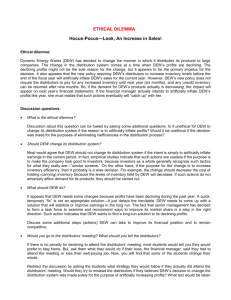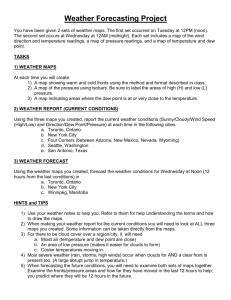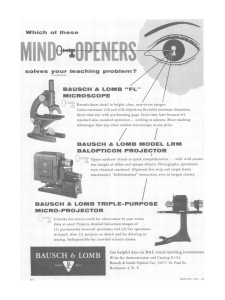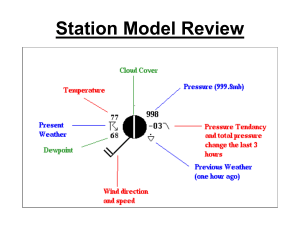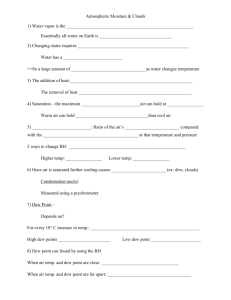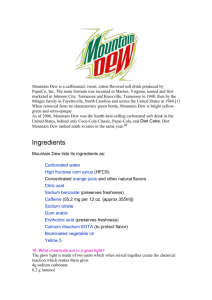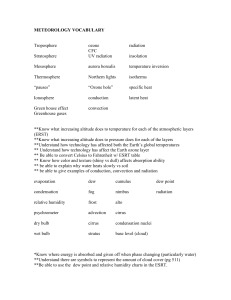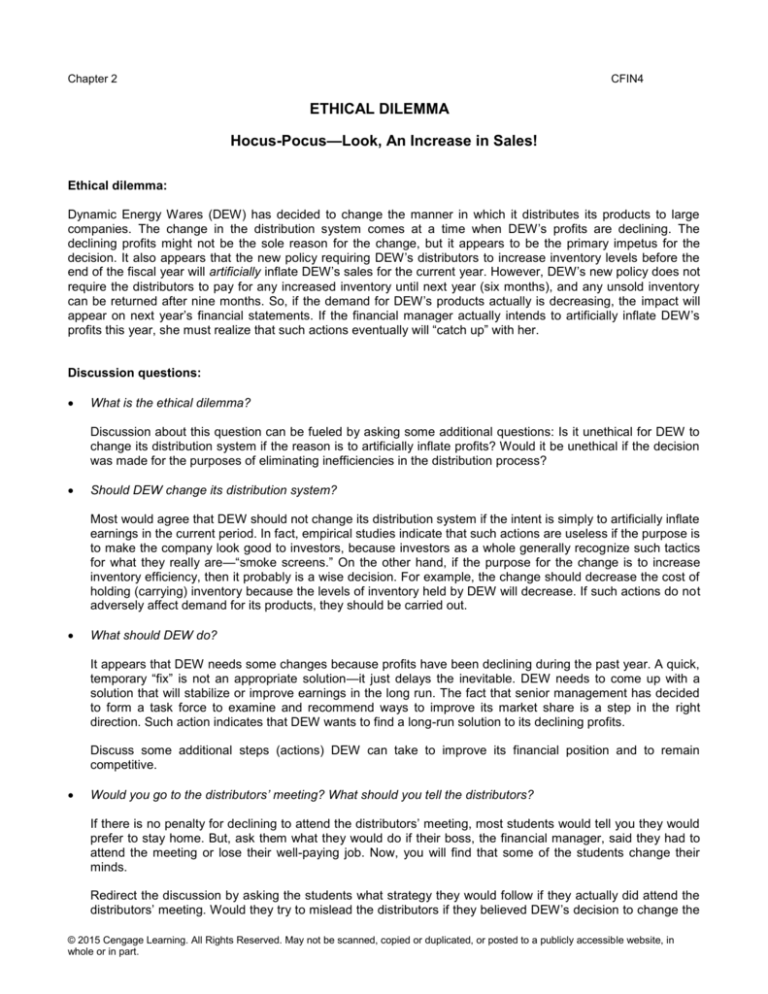
Chapter 2
CFIN4
ETHICAL DILEMMA
Hocus-Pocus—Look, An Increase in Sales!
Ethical dilemma:
Dynamic Energy Wares (DEW) has decided to change the manner in which it distributes its products to large
companies. The change in the distribution system comes at a time when DEW’s profits are declining. The
declining profits might not be the sole reason for the change, but it appears to be the primary impetus for the
decision. It also appears that the new policy requiring DEW’s distributors to increase inventory levels before the
end of the fiscal year will artificially inflate DEW’s sales for the current year. However, DEW’s new policy does not
require the distributors to pay for any increased inventory until next year (six months), and any unsold inventory
can be returned after nine months. So, if the demand for DEW’s products actually is decreasing, the impact will
appear on next year’s financial statements. If the financial manager actually intends to artificially inflate DEW’s
profits this year, she must realize that such actions eventually will “catch up” with her.
Discussion questions:
What is the ethical dilemma?
Discussion about this question can be fueled by asking some additional questions: Is it unethical for DEW to
change its distribution system if the reason is to artificially inflate profits? Would it be unethical if the decision
was made for the purposes of eliminating inefficiencies in the distribution process?
Should DEW change its distribution system?
Most would agree that DEW should not change its distribution system if the intent is simply to artificially inflate
earnings in the current period. In fact, empirical studies indicate that such actions are useless if the purpose is
to make the company look good to investors, because investors as a whole generally recognize such tactics
for what they really are—“smoke screens.” On the other hand, if the purpose for the change is to increase
inventory efficiency, then it probably is a wise decision. For example, the change should decrease the cost of
holding (carrying) inventory because the levels of inventory held by DEW will decrease. If such actions do not
adversely affect demand for its products, they should be carried out.
What should DEW do?
It appears that DEW needs some changes because profits have been declining during the past year. A quick,
temporary “fix” is not an appropriate solution—it just delays the inevitable. DEW needs to come up with a
solution that will stabilize or improve earnings in the long run. The fact that senior management has decided
to form a task force to examine and recommend ways to improve its market share is a step in the right
direction. Such action indicates that DEW wants to find a long-run solution to its declining profits.
Discuss some additional steps (actions) DEW can take to improve its financial position and to remain
competitive.
Would you go to the distributors’ meeting? What should you tell the distributors?
If there is no penalty for declining to attend the distributors’ meeting, most students would tell you they would
prefer to stay home. But, ask them what they would do if their boss, the financial manager, said they had to
attend the meeting or lose their well-paying job. Now, you will find that some of the students change their
minds.
Redirect the discussion by asking the students what strategy they would follow if they actually did attend the
distributors’ meeting. Would they try to mislead the distributors if they believed DEW’s decision to change the
© 2015 Cengage Learning. All Rights Reserved. May not be scanned, copied or duplicated, or posted to a publicly accessible website, in
whole or in part.
Chapter 2
CFIN4
distribution system was made solely for the purpose of artificially increasing profits? What tact would be taken
if they believed the decision ultimately would improve inventory efficiency for both DEW and the distributors?
How would distributors concerns be handled? The answers to these questions will be varied. But, you
probably will find the discussion has an underlying theme—while many believe it is part of the business world,
most students will express discomfort with the prospect of having to overtly mislead others.
References:
There have been many reports of firms that have followed a strategy similar to that described in this chapter's
ethical dilemma. A couple of classic examples occurred in 1994—one involved Bausch & Lomb, Inc., which is a
well-known eyewear company; the other involved PerSeptive Biosystems, which produces instruments used in
biotechnology analysis.
In the last quarter of 1993, Bausch & Lomb instituted a change in its distribution system that helped reduce
inventories significantly and allowed the company to post a $10 million gain for the quarter. Midway through 1994,
however, Bausch & Lomb estimated its distributors had excess inventory equal to $75 million. During the year, the
company had to repurchase much of this excess inventory because it could not be sold by the distributors.
Because of the poor performance of Bausch & Lomb in 1994, the CEO’s performance bonus was cut to zero.
Additional information concerning Bausch & Lomb's decision to change its distribution system can be found in the
following articles:
“Bausch & Lomb: Clouded Vision,” Financial World, May 23, 1995, p. 16+.
“Bad Math at Bausch & Lomb?,” Business Week, December 19, 1994, p. 108+.
“Bausch & Lomb's Myopia,” Forbes, December 5, 1994, p. 14+.
It was reported that PerSeptive would offer its diagnostic equipment, some of which cost in excess of $50,000, to
prospective customers on a trial basis, requiring payment at some later date only if the equipment was found to
be desirable. At the time, PerSeptive's management stated the strategy was to increase renewable sales by
allowing the market to experience its product firsthand before requiring a purchase commitment. Even though the
trial offers were not technically considered sales, in some instances, PerSeptive recorded them as sales and
corresponding receivables. For the quarter ending September 30, 1994, PerSeptive posted nearly a $21 million
loss because it wrote off a large amount of inventory and had to reduce accounts receivable significantly. Its “free
trial” offer did not generate the renewable sales that it hoped. For more information about PerSeptive and this
situation, the following articles might be helpful:
"PerSeptive Restates Its Results for Much of Past 2 Fiscal Years," The Wall Street Journal, December 28, 1994.
"Biotech Company Is Questioned About 'Try It Out' Sales Strategy," The Wall Street Journal, November 8, 1994,
p. B1+.
"Enterprise: Tech Concerns Fudge Figures to Buoy Stocks," The Wall Street Journal, May 19, 1994, p. B1+.
As you know, there are quite a few examples of “misjudgments” in the applications of accounting practices that
have been reported in recent times, including the famous Enron situation. Recent articles that relate these
misjudgments include the following:
"Accounting Abracadabra: Cooking the Books Proves Common Trick of the Trade," USA Today, August 11, 1998,
p. 1B.
"More Second-Guessing: Markets Need Better Disclosure of Earnings Management," Barron’s, August 24, 1998,
p. 47.
"SEC Probes Telxon’s Accounting Practices, Unusual Securities Trading," Dow Jones Business News, February
© 2015 Cengage Learning. All Rights Reserved. May not be scanned, copied or duplicated, or posted to a publicly accessible website, in
whole or in part.
Chapter 2
CFIN4
22, 1999.
"Rite Aid Restates Year Net Downward, Reversing Some Accounting Maneuvers," The Wall Street Journal, June
2, 1999, p. A3.
© 2015 Cengage Learning. All Rights Reserved. May not be scanned, copied or duplicated, or posted to a publicly accessible website, in
whole or in part.

